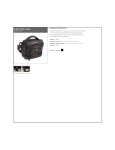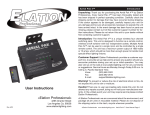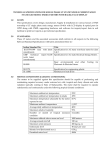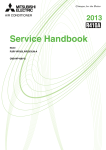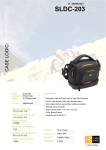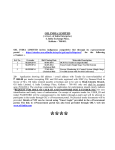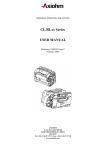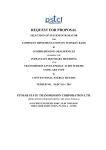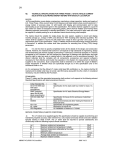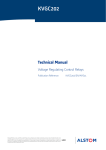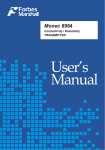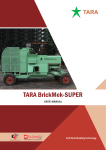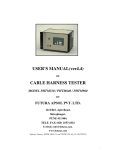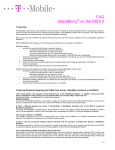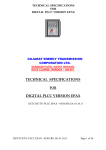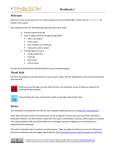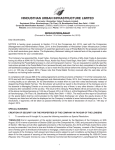Download Technical specification for Development of Energy
Transcript
TECHNICAL SPECIFICATION FOR Development of Energy Accounting & Scheduling Software With Automatic Meter Reading (AMR) solution at SLDC Gotri. TENDER NO: GETCO/ABT Software/SLDC/50 PART – II GUJARAT ENERGY TRANSMISSION CORPORATION LIMITED SARDAR PATEL VIDYUT BHAVAN RACE COURSE, VADODARA - 390 007 Seal & Signature of Bidder 1 INDEX CLAUSE NO. TITLE PAGE NO. Technical Specification (TSP) (I) 1 2 3 Detail Scope of Work Scheduling Energy accounting Automatic meter reading. 3 5 9 4 System Design Outline. 11 (II) Special Technical Terms and Condition 5 6 7 8 9 10 General Demonstration Right of Owner Confidentially Method of Project Implementation Acceptance Certificate 17 18 18 18 18 18 11 12 13 14 Support during warranty and AMC Future Migration Functionality Compliance Performance Bench Mark for SAT (Guaranteed Technical particulars) Documentation 19 19 19 19 15 20 Annexure A- Scheduling flow chart. Annexure B- Energy accounting flow chart. Annexure C- Detail of Server installed at SLDC. Annexure D- Proposed Architecture of ABT system. Seal & Signature of Bidder 2 Section-I Detail Scope of Work The proposed solution is broadly divided in to two parts: Scheduling and Energy Accounting. AMR (Automatic Meter Reading). 1.) Scheduling: It comprise of following Modules Module 1: Declared Capacity • Resources: o Submission by generator(s) in 15 minutes time block(s) in ‘Day ahead’ and every • • revision thereof. Output: o Base for every module and to be processed as per set rules. Report: To be display on website (generator wise) Module 2: Entitlement: • • • Resources: o DC of the generator(s) in 15 minutes time block(s) in ‘Day ahead’ and for every revision thereof. o Share allocation from each generator(s) to beneficiary/ beneficiaries Output: o Base for requisition to be submitted by beneficiary / beneficiaries and as per set rules Report: To be displayed on website (constituent/generator wise) Module 3: Drawl Schedule • • • Resources: o Requisition submitted by beneficiary/ beneficiaries o Inclusion of bilateral schedules Output: to be processed as per set rule. Report: To be displayed on website (constituent/generator wise) Module 4: Generator Schedule • • • Resources: o Requisition submitted by beneficiary / beneficiaries o Inclusion of bilateral schedules Output: to be processed as per set rule. Report: To be displayed on website (generator wise) Seal & Signature of Bidder 3 Module 5: Surplus Schedule • • • Resources: o DC of the generator(s) in 15 minutes time block(s) in ‘Day ahead’ and for every revision thereof. o Schedule of the generator(s) in 15 minutes time block(s) in ‘Day ahead’ and for every revision thereof. Output: to be processed as per set rules Reports: To be displayed on website (generator wise) Module 6: Bilateral schedule • • • Resources: o Requirement from beneficiaries/entities. o Bilateral schedule approved by RLDC(s)/Power exchange(s) Output: to be incorporated in drawl schedule as per set rules Reports: To be displayed on website (generator wise/trader wise/link wise as per user requirement) 1.1 Additional features: (1) Software shall be able to handle multiple losses treatment in the state. a. STU network transmission loss b. Pooled transmission loss. ( Common ABT network loss) (2) Merchant power plants, UMPPs are having special scheduling treatment. Software shall be able to do it. a. Scheduling of UMPP. i. Any UMPP has multiple LTOA/MTOA beneficiaries (having specific share allocation) in the state as well as outside of the state. ii. Among the beneficiaries some uses its own dedicated network (no utilization of STU network), some uses dedicated network as well as STU network at a time. Loss treatment is as per the use of network. Some uses only STU network. iii. Any UMPP has some spare capacity for sale outside the state under bilateral or through power exchange. iv. URS of beneficiaries utilize among themselves on need basis. (3) Software shall be able to schedule sale of Surplus power of generator (after fulfilling the requirement of beneficiaries) through bilateral as well as power exchange. (4) In a web based scheduling module, it is preferable to get the data of central sector directly from through its website or other means. (5) It is also proposed to get scheduled data through power exchanges directly from its web site or other means. (6) State Energy Accounts shall be able to prepare without manual intervention in a prescribed formats. (7) Software shall be able to schedule in case of future installation of HVDC lines. (8) Data to be displayed on website in line with WRLDC as well as customized modules to be developed in consultation with SLDC. (9) Software should be capable to use variety of methodology each category of Generation/Beneficiaries without manual intervention. Software should be capable to integrate and communicate with all stake holders through web integration. (10)The necessary flowchart (Annexure A) for various scheduling activities are attached herewith, however detail business logic for scheduling-entity wise will be explained to successful bidders. Seal & Signature of Bidder 4 (11) General scope of scheduling model is from Declaring Generation availability to Discom’s requisition and schedule for all stake holders and revision thereof in real time as well as Day ahead with all reports and web integrated module. (12) All required data entry of scheduling activities is to be done through web based application only. (13) As per requisition of DISCOM(s), it should be automatically scheduled as per set business logic, including Allocation of ‘On bar’ & ‘Off bar’ available generation. (14) There should be differentiation between ‘On bar’ & ‘Off bar’ available generation and real time scheduling is to be carried out w.r.t available ‘On bar’ generation. (15) Software shall be compatible with provisions of POC regulation, RRF regulation and other regulation issued time to time. (16) The software should generate log on Economic Dispatch of power for State Grid in real time as well as day ahead once schedule prepared and it should be on Index base that schedule is how much deviated from Economic Dispatch. Necessary logic will be given by SLDC. 2) Energy accounting: It is comprise of following modules. Module 1: State Energy Accounting The State energy accounting shall be done for • Availability • Schedule Energy • Plant load factor • Open access bilateral schedule and collective schedule • Incentive calculation of generating station and apportion it to respective beneficiaries, etc. The State energy account shall comprise calculation of Availability and Schedule Energy for each generating station and beneficiaries individually. PLF and incentive calculation will be based on implemented schedule. The Provisional SEA will be primed on monthly basis and posted on website. It is reconciled if any observation received from stack holders. Resources: • Day wise DC of all Generators in 15 minute blocks. • Schedule of all beneficiaries in 15 minute blocks. • Incentive calculation as per PPA • STOA Schedule in 15 minute blocks day wise Reports: • Beneficiary wise Availability and Schedule Energy Reports for the month • STOA contract report Module 2: Meter data processing The software shall process the meter data for grouping into logical entities like Generating station and Distribution Company. The grouping shall be configurable by the user (i.e. exclusively customize by user). Seal & Signature of Bidder 5 Resources: • The accounting shall be based on the readings taken in SEM meters installed at interface points through AMR. Outputs: • Processed data grouping into logical entities wise use for UI,REC bill preparation Module 3: UI Bill Accounting Unscheduled interchange energy for all the beneficiaries shall be calculated based on Intra state ABT regulations. Balancing and settlement of UI shall be done based on Balancing and settlement mechanism notified by regulatory commission. UI bill for the same shall be prepared and posted on website. The UI will be calculated for the generating station, distribution licenses and other open access users. The State UI Pool A/C will be balanced back to back with the Regional UI Pool A/C issued by WRPC/WRLDC. Resources: • Implemented Schedule in 15 minute blocks • Processed meter data grouping into logical entities wise in 15 minute blocks Outputs: • UI Bill on weekly base Module 4: Reactive energy charges balancing and settlement of Interstate REC charges Reactive energy exchange between beneficiaries shall be calculated based on Intra state ABT regulations. Balancing and settlement of REC shall be done based on Balancing and settlement mechanism notified by regulatory commission. REC bill for the same shall be prepared and posted on website. The State REC Pool A/C will be incorporated Inter state Reactive energy exchange charges issued by WRPC/WRLDC. Resources: • Processed meter data grouping into logical entities for HV and LV condition Outputs: • REC Bill on weekly base • Module 5: REC charges Invoice as per WRPC REC Bill WRPC/WRLDC prepare Reactive energy exchange bill between interstate entities connected with state grid and available on WRPC website. Reactive energy charges invoices will be prepared. Resources: • REC Bill available on WRPC website Seal & Signature of Bidder 6 Outputs: • Invoices for REC charges Module 6: Open access Approvals, charges calculation and preparing Invoices OA approval preparation as per notified by regulatory commission as per standard format, and data base for OA users. Creation of various OA details report. OA charges includes transmission charges, system operation charges and distribution charges etc. will be calculated based on the Open access regulations notified by the regulatory commission. The injection/ drawal of OA customer shall be obtained from Energy Accounting and implemented schedules. Invoice of the same shall be prepared and send to open access customers. Resources: • STOA schedule. • STOA application details. Outputs: • STOA • STOA details report as per customized by SLDC. • Invoices for various charges to STOA users. Module 7: Wind energy allocation and certification SEM Meter data are received from WF pooling station at SLDC same meter reading to be processed in software and derived energy to be sent to GEDA for wind developer wise energy bifurcation. From GEDA submission, Beneficiary wise allocation is to be incorporated in UI bill. Wind certificate will be prepared monthly from the same data and to be posted on website .Also it is to be incorporated in SEA bill for different Discom set off as per their allocation. Resources: • Processed meter data grouping into logical entities wise in 15 minute blocks • GEDA wind allocation Reports Outputs: • Wind certificate • Wind data in SEA bill Module 8: Transmission Loss calculation for the state • State Transmission Loss: Loss calculation for the state boundary using Field data of various interface points (i.e. Generation to Transmission, Transmission to Distribution). Same data should be entered and corrected at GETCO Circle offices within defined time duration. Seal & Signature of Bidder 7 Resources: • Meter data entry to be carried out at GETCO circle offices as per joint meter reading sheet prepared in presence of GETCO/DISCOMs representatives. Outputs: • State Transmission Loss Module 9: RRF Accounting. The scheduling, metering, energy accounting and accounting of Unscheduled Interchange (UI) charges would be as per the RRF Regulations of the Central Commission. Resources: • Implemented Schedule in 15 minute blocks • Processed meter data grouping into logical entities wise in 15 minute blocks Outputs: • RRF Bill on weekly base Module 10: Presentation – Graphical user interface (GUI) & Reporting The software shall be presented in web based GUI. The flow shall be user friendly and have a customary look & feel. Raw and processed information shall be presented in both tabular and graphical formats. The reporting shall be widespread including Executive/ Operator information, Management Information, Customer information, Regulatory compliance information (like ERC and RTI) etc. The design of reports shall be optimal to reduce carbon foot print of SLDC. Layout and no. of pages to be consumed to report specific information shall be optimized. The format of reports shall be customized as per requirement of SLDC and shall be capable to incorporate changes in user friendly manner. Reporting tool shall be provided for the users to generate reports by them in future. Presently required reports are explained in the technical specifications. However, solution must be capable to generate various reports using the parameters of the proposed integrated ABT solution. (Flow charts for Energy Accounting is Annexed in Annexure-B) Seal & Signature of Bidder 8 3) Automatic meter reading 3.1) It is proposed to establish Automatic Meter Reading (AMR) solution which shall fetch the data from the existing meters using special server to be provided at control center SLDC. Presently there is a 1200 meter at 250 locations in Gujarat. Control center hardware and software should be capable to handle 5000 meters & 1000 locations in future. The present arrangement to fetch data from meters is either by local PC at substation or using hand held MRI device. Further these meter data is send to SLDC using email 3.2) The location wise existing meter details are available on SLDC web site http://www.sldcguj.com/commercial/abtmeterdetail/2011/DEC/DEC2011.pdf 3.3) The Tri-party agreement will be carried out between GETCO-SLDC, Successful bidder and Meter manufacturers for extending Meter protocol from Meter manufacturer to successful bidder under Non Disclosure Agreement (NDA) for smooth completion and working of AMR 3.4) Features: Periodicity of data collection System shall be capable of collecting data from all the Special Energy Meters (SEM) in sub-stations at every 15 mins interval on real time basis. Though currently meter data is captured on weekly basis manually and this frequency may remain same in future. Availability of sufficient storage capacity The system shall have sufficient capacity for storing data of all connected remote modems or Data loggers in the substations. Ability of software to integrate, extract and analyze data of different make of Meters Software shall be capable of collecting data on a common data structure / format from meters of various manufacturers. The data logging software package should be able to integrate, extract and analyze data of different make of Meters. Manual/ automatic mode of data transmission There should be provision for communicating with meter on scheduled basis or on demand basis. Viewing / exporting of collected data The collected data can be viewed in the form of customized reports. User can take print outs of these reports, export the data into spreadsheets, or convert the data in the form of flat file. Mode of transfer of Meter data Intelligent modems should send the data directly to server. Interval of the data transmitting should be configurable. It will be pull mechanism to get data from meter. Configurable data collection engine for meters of different make The Data collection engine of the Data logging software shall be configurable for Meter of different make and shall have the ability to acquire data from Special Energy Meters. Provision of On demand reading Meter reading of 96 blocks will be possible in both scheduled batch mode (automated) as well as in the on-demand mode. In real time mode, provision should be there to capture instantaneous and counter parameters every 15 minutes and provision to capture data on hourly/daily basis. User should able to configure the designated meter for real time meter data acquisition. Seal & Signature of Bidder 9 Features of scheduled mode of data collection In the scheduled mode of data collection, the software will allow reading cycles to be configured for either individual meters or groups of meters. Appropriate time windows for data collection from different meters based on location/type can be set. The data collection could be at any one of the pre-defined weekly, monthly, daily, hourly or quarter-hourly, 15 minutes, every minute frequency. In case of daily, weekly, monthly frequencies, system should be capable of capturing the meter data of all 96 blocks. Fictitious Meters It shall be possible to logically group physical meter locations and name it as per the existing system. Such meters can be regarded as Fictitious meters Support for both inbound and outbound communication The software will support communication with meters Type of Inbound communication At minimum, inbound communication will include event notification calls for power outage and restoration events. The event driven polling of meters shall enable pinpointing of faults during outages, defective or stopped meter Support for import of meter data The software will support import of meter data from external sources in industry standard formats like ASCII, CSV or XML. It will also allow manual entry of meter data in exceptional cases only with appropriate user identification, security and audit trail. The input sources of meter data could be DCD (Data Collection Device) / CMRIs (Common Meter Reading Instruments) both inbound and outbound 3.5) Communication The communication between Meters to Control centre has to be arranged by bidder and the whole responsibility from initial establishment to complete AMC period is in the scope of bidder only. However as per TRAI rules the ownership of link will be on the name of CE (SLDC) and necessary SLA (Service level Agreement for 99% guaranteed up time) with Communication Company will be done by SLDC. The bidder has to coordinate all things right from application to bill payment and operating SLA on behalf of SLDC ensuring satisfactory services. 3.6) Wiring and cabling All inter connection wiring with required capacity cable etc. for AMR Will be in the scope of the bidder at all meter sites. 3.7) Site Survey Site survey of existing meters site for the AMR will be in the scope of the bidder and bidder should provide AMR solution with existing meters and this should be clearly mentioned in their prototype and proposal. Seal & Signature of Bidder 10 4) System Design Outline: In order to address reliable integrity and support bidders should develop their solution on standard product like Meter data Management and load profile survey and billing settlement utilities and BI publisher of Oracle or equally versatile, renowned, time tested and proven platform referred at clause 4.2 and 4.3 with necessary customization and ensure but not restricted to the features explained in technical specification with achieving Guaranteed Technical parameters.. 4.1) General 4.1.1) Suitable solution shall be proposed to enable SLDC to interact through web with entities like RLDC, Generation companies, Distribution companies, Open Access Customers, IEX, and PEX for information exchange. The solution shall remove/ reduce manual intervention as far as possible. Manual intervention shall be required only for verification and authentication purpose. 4.1.2) The system shall be designed in such a fashion that when there is a change in regulation / methodology / as per requirement of SLDC, it requires only change in configuration. However when there is a considerable shift in the regulations after freezing of Functional design specification, and that cannot be handled by configuration changes, the issue shall be discussed on case by case basis between SLDC and implementing agency. The changes must be incorporated by implementing agency in such a manner that the routine activities should not be affected. 4.1.3) The offered system shall be complete with all components and software necessary for their intended purpose. The design, engineering, development, testing at works, supply, installation, testing and commissioning at site of total system shall be deemed to be within the scope of bidder’s supply irrespective of whether those are specifically brought out in this specification or not. 4.1.4) The bidder should confirm the portability of their package on all possible major hardware & should ensure compatibility with up gradation/change in operating system (server & client), Backend & network for the life cycle of package. 4.1.5) The licensed database (oracle 11g) and control centre data base server (Active-Passive configuration) will be provided by SLDC-GETCO, the detail of server is attached in Annexure C. The proposed ABT Software should be compatible with the given database server. 4.1.6) Website module development to display above data is also a part of this project. Existing Webserver & website will be utilized for the same. For interactive access to the website presently 70 users but the solution should not be restricted to this. 4.1.7) The proposed architecture as envisaged is placed at Annexure D .However, Bidder may submit their proposed architecture covering best technical solution for the project. 4.1.8) The control center servers provided by the bidder must be suitable rack mounted. Seal & Signature of Bidder 11 4.1.9) The vendor should provide necessary up dates compatible to upcoming new user interface, backend and reporting software tools during AMC period of the product cycle. The licensed tools for up gradation will be provided by SLDC. 4.2) Features of Meter data Management and load profile survey. 4.2.1) The bidder must have Authorization right from the MDM and load profile survey developer or its equivalent used by bidder for continuous technological support from original MDM and load profile survey developer without any condition and bidder has to submit this original authorization letter to SLDC. 4.2.2) The bidder must have capacity to customize the MDM platform and load profile survey up to the extent of requirement of SLDC, in this regard bidder has to assure SLDC during prototype presentation and development stage. 4.2.3) The proposed MDM should have following functionality mainly but not limited to that. 1. 2. 3. 4. 5. 6. • Solution should be able to interface (meter reads and meter events data) of MDAS via multiple interfaces a) b) c) d) • • • • • Data receipt Data Validation and Estimating (VEE) Aggregation and Affiliation Storage Interface to the other Entities Reporting as per required format CSV XML Web Services Database Solution should have built in out-of-the-box Validating, Editing, and Estimation (VEE). Solution should have pre-defined validation algorithms based on scalar, interval and time of use/day meters. Solution should have ability to define profile meter (for example meters at both end of the lines) and validate meter reads within given range. Solution should have ability to time synchronize the drift in meters. Solution should have following mandatory validations inbuilt like a) Usage of inactive meters b) Meter identification c) Invalid Dates/Times d) Verify stop date/time is greater than start date/time e) Invalid unit of Measure Seal & Signature of Bidder 12 • Solution should have additional validations like a) b) c) d) e) f) g) h) i) j) • • • • • • • • • • • • • Replacement Flag Replacement Overlap Revenue Protection Check Meter Multiplier Zero Consumption Serial Number Spike Check Interval High/Low Check Check Energy Sum Test Mode Solution should capture Meter Assets including (Meter Serial Number, Manufacture, start and stop dates, etc.) Should Stores meter data in one (1) central repository and acts as a service to other applications, users, and customers. Supports open technologies to allow easy integration with other systems. Should Maintains an audit trail of all changes made. Automatically edit meter data like Replace or change intervals, Copy and replace intervals, Add or delete intervals, Factor intervals. Automatically estimate meter data like Estimate by linear interpolation, Estimate by calculating average daily data, Estimate using interval data for the previous day. Configure customizable VEE rules o Have pre-defined validation rules that can be adjusted using parameters o Have the ability to define a new formula for validation rules (using GUI) o Have the ability to define a new routine for editing or estimation (using GUI) o Have the ability to turn on and off the VEE rules o Configure estimation routines for a specific group of meters / accounts Define complex validation rules that would execute a series of validation routines depending on the severity of exceptions. Should have formal process for historical versions and audit trails Should have Integrated exceptions management that provides a platform and process for you to efficiently manage work It should be possible to enable End-User Access via thin-client user interface by the application of row level security to allow a given user to see only their data System required to generate following reports: These out-of-the-box reports include the following:· Adapter interface status report· Closed Work Queues detail report· Population summary by meter read system report· Population summary by read cycle report· Missing reads report· Physical meter events report· Revenue protection usage events report· Usage exceptions report Generation of MIS reports based on the results of data analysis integrate with third party reporting tools like Oracle BI Publisher MDMS to integrate with AMR and AMI support one-way and two way communication with meters. Seal & Signature of Bidder 13 • Ability to create virtual meters/net meters (addition/substation of group of meters measurements) 4.2.4) Load profile survey or its equivalent standard software should be capable to perform all the requirement of scheduling and Energy accounting specifified here after in technical specification. The software must have following capacity but not limited to this. • • • • • • • Ability to calculate UI (Unscheduled Charges) based on ABT tariff for market participants based on the frequency and regulation. Ability to store ABT tariff and make changes as per regulator guide lines Ability for solution to add validation checks like Cap rate, open access energy and other specified by SLDC time to time. Generating various profile as per user requirement based on UI billing and Meter data. Self validating as per pre-define criteria and generating log of this. Any addition, modification, alteration in user friendly way and version base. Use of Integrated data in required format, from web for the different Entities. 4.3) Data Reporting 4.3.1) Reporting tool should be used like BI publisher of Oracle or its equivalent, versatile and proved one for the various reports creation, web integration of reports. 4.3.2) The bidder must have Authorization right from BI publisher or its equivalent developer used by bidder for continuous technological support from original developer without any condition and bidder has to submit this original authorization letter to SLDC. 4.3.3) General data report: The formats of the report will be finalized while defining User Requirement Specifications (URS) and Detail Functional Specifications (DFS). This need to be customization in due course after running the software and gaining some experience on implications of ABT/Scheduling based operation. 4.3.4) Search and report capabilities: ABT/Scheduling System Software should provide fast, easy and quality search capability to locate and report any historical data. It provides multiple options to search as per the user requirement. 4.3.5) Plotting Of Trend The Reporting Tool should support Real-Time Trend and Historical Trend using Add-In that comes with the Reporting tools 4.3.6) Report as per user requirement should be generated and placed at reporting server and out side world should be allowed to take these reports from report server. 4.3.7) Report must be as per user requirement based on this project and must store at report server, any change, modification, alteration must be user friendly and version base. 4.4) User interface flexibility: The total solution must be web based; Web user interface has the flexibility to meet the changing business needs. All the users including SLDC users presently 15nos, which may increase up to 25nos however, system performance should not affect with the increase in the numbers of users. All such users will have a prevailage to operate and execute any or all of the modules through web interface & client login provided by vendor with proper authorization and rights. Seal & Signature of Bidder 14 4.5) Flexible data format: The system should able to access, retain and process the ABT meter data and schedule parameters right from 5th April-2010 for all future process and analysis. It also has an ODBC (Oracle Data Base Connectivity) compliant database interface to the historian. It should also offer a mechanism for importing old data from Excel,csv etc.. 4.6) Efficient data storage and flexible data compression ABT/Scheduling System Software shall include disk saving oriented mechanisms called as 'data compression' in order to optimize the size of the data base archive without losing valuable information. The system should also allow for defining the compression parameters for each tag, according to the tag nature, type and data criticality. The setting of the data compression parameters impacts the historical database size and consequently on the hard disk storage required. Data archiving to external storage and restoring from external storage shall be done without interrupting the current running of the ABT/Scheduling System. 4.7) Statistics/Summary Data: ABT/Scheduling System Software should have the ability to store summary data for past years in a database for historical analysis and a Totalize function that support summary calculations like Total, Average, Min, Max, Range, etc. 4.8) Advanced Calculation Functions The ABT/Scheduling System Software should provide facility to build/modify required ABT/Scheduling Calculation based on Visual Basic or .Net. or other latest technology. 4.9) Data Archiving & Backup Users should be able to copy ABT/Scheduling data to removable media such as magnetic tape or other suitable media supported by the ABT/Scheduling System for Long term archiving, and to retrieve archived data back into the ABT/Scheduling System. Useroriented procedures, which do not require programming, or database querying skills, are provided to take back-up. The ABT/Scheduling System Software should have ability to limit access to data by user ID. 4.10) Checking Simulator: System should provide checking stimulator. Necessary logic will be provided by SLDC. This checking must be questionnaire basis and system should generate log of checking report with different logic and results. SLDC will check reliability of reports and process. Vendor should be responsible to do appropriate change in the process in consultation with SLDC. During the various stage of process necessary check and recheck of data and output shall be carried out to ensure correct functionality. For which necessary logic shall be provided to stimulate the data, to avoid wrong or unreliable results at final stage. 4.11) Security: The ABT/Scheduling System Software shall have following security features: Limit the number of users for certain applications. Tag / Parameter level security should be possible. There shall be a separate audit function which records any manual changes to either the tag configuration, system configuration or any tag value. These changes captured in the audit function shall reside in the server machine. The audit file data should be in a log file structure which can be read using notepad. Seal & Signature of Bidder 15 4.12) Quality Assurance All design, processing, testing, commissioning & inspection operation affecting the ABT/Scheduling process shall be governed by quality assurance producers in accordance with the relevant standards. Seal & Signature of Bidder 16 Section-II Special Technical Terms and Condition. 5.) GENERAL 5.1) Bidder has to furnish/demonstrate functional capability of various process cycle right from every meter data up to final/revise bill as per the requirement of EIC of the project during technical evaluation of the tender within given time frame. CE (SLDC) will be EIC of the project. 5.2) The bidder shall visit site with the prior intimation for assessing the detailed scope of work prior to quoting bid. No claims for inadequate description of the scope shall be entertained at a later date. 5.3) Bidder has to comply each & every points/sub points of the all sections of functional specifications. 5.4) Security is the main key features for this application; users need total authentication and authorization for secured application. 5.5) Application will be able to handle as many users as decided by EIC without compromising quality, quantity & functionality. 5.6) Addition / Alteration / modification of users will be accommodated in the application as per their right and log must be generated for each users. 5.7) The bidder shall implement the present methodology and likely to implement must be incorporated in the software. 5.8) The software should have a provision to retain all updates as version with associated effective date so as to facilitate processing of past data as needed. 5.9) Any Enhancement or renewal of the software licenses will be in the scope of Bidder. Dealing with any third party vendor / supplier for third party software / hardware / supply issues will be in the scope of Bidder. 5.10) Database administration & its related activity like database backup, updating & deletion will be in the scope of bidder. The optimal online retention period shall be minimum 5 years. 5.11) Data Storage (retention Period), Backup and Restoration, And Disaster Recovery Data storage server shall be used to perform Information Storage/ archival and Retrieval functions. The methodology adopted for retrieving data both within and outside retention period is to be provided by bidder as per user requirement. The design/architecture of database should support the redundancy feature of oracle. It shall operate in a primarystandby redundancy mode i.e. if primary server crashes the standby automatically takes over it. Data storage server shall also perform the task of taking backup on the external storage devices (such as disk arrays, tape libraries and optical jukeboxes etc.) connected in the network in such a way that the devices appear as locally attached to the operating system. It shall also be possible to recover the data from external storage in case of failure of server. Further it shall be possible to do data backup & restoration to/ from DVD/ Tape/ External HDD based storage devices. The same has to be carried out during warranty support and AMC period. 5.12) It shall also be capable to receive & process simultaneous request from multiple users for generating and managing different types of specified reports e.g. historical trending etc. The Database shall be relational data base which shall be queried through SQL etc and shall be suitably sized for complete data storage. Disaster Recovery Database shall be able to store data from software and processed data with suitable automatic backup at some suitable remote location (identified by SLDC) for disaster recovery as planned in future. 5.13) Vendor shall study the specifications available in detail and with GETCO coordinator or SLDC will explain the system requirements to the best of his knowledge. The missing links and details in the specifications or any processing or functional requirements discovered at the time of testing should NOT be treated as out of scope. 5.14) There must be provision for following in the software as per the requirement. Events and alarms. Executive Dashboard. Data analysis and charting. Seal & Signature of Bidder 17 6) DEMONSTRATION The bidder needs to make full fledge prototype demonstration of: AMR: Collection of on demand ABT meter data from field stations at SLDC [on bidder’s demo setup] using suitable mobile communication technology. ABT: Entire process right from ABT meter reading to issue of State Energy Accounting and UI bill covering all modules as referred in the tender. The prospective bidders should consult SLDC to get logical knowhow of proposed ABT software package preferably from submission of offer. So, that bidder can start developing prototype demonstration with in 30 days, when called for by the SLDC during technical evaluation of the bid. No additional time shall be allowed to develop & demonstrate the prototype so bidders are requested to equip themselves as early as possible. Therefore, prospective bidder has to understand the preliminary logic and complying with entire process right from ABT meter reading to issue of State Energy Accounting and UI bill. Bidder shall make full fledged demonstration as requested, for technically qualifying in the bid process, failing of which the offer will be rejected. 7.) RIGHT OF OWNER Not withstanding anything stated above, the owner reserves the right to assess bidder’s capacity to perform the contract, should circumstances warrant such an assessment in the overall interest of the contract and the Owner 8.) CONFIDENTIALLY All information, data and drawing furnished / disclosed by the purchaser to the bidder/supplier and all drawings , calculations , models , technical information and the like supplied by the supplier to the owner , will be treated as confidential and shall not be used by the supplier or not released to a third party without the prior written consent of the purchaser. 9.) METHODOLOGY OF PROJECT IMPLEMENTATION The successful bidder shall furnish action plan with Bar chart within a period of 15 days of the date of receipt of communication about the acceptance of their offer and this period shall commence from the date of letter of intent in case the detail order is issued later. The action plan shall be submitted to SLDC-GETCO for approval for execution of contract. The action plan shall cover preparation of URS ( User requirement specification) and its approval , preparation of DFS ( Detail functional specifications) and its approval software development and its validation, trial runs, training, user feed back , commercial roll out , hand out , instruction manual etc. Project implementation should be carried out without affecting work of the existing system. Any network related issues within ABT/Scheduling system and interfacing with existing system for complete working of the project should have to be tackled and resolved by the bidder; Any special tools - tackles, Hardware, software, Man power, etc…. required for the implementation of the project shall be arranged by the bidder. 10.) ACCEPTANCE CERTIFICATE Upon successful completion of all the functionalities/tests to be performed at the site, and on completion of a successful trial run, the engineer in charge of SLDC shall issue an acceptance certificate to the bidder. Seal & Signature of Bidder 18 11) SUPPORT DURING WARRANTY AND AMC: 11.1) The bidder shall provide 1(one) year warranty & five year AMC from the date of acceptance of the package. 11.2) The developer need to maintain, update and fine tune all the modules, sub modules during AMC as suggested by SLDC from time to time. This will also include regular backup and restore of data as the need arise for revision of the past bill etc. during the AMC period. Developer should demonstrate and maintain all performance parameters indicated in the tender document during warranty and AMC period, failing to which penalty shall be imposed and SLDC reserve the right to impose quantum of penalty rate depends upon severity of unavailable/unreliable modules. All arrangements shall be made in advance by developers to avoid such phenomena because 100% availability and reliability of all modules is the mandate of the project. 11.3) During warranty and AMC period in which physical presence of competent technical person is required at control centre SLDC on working days during business hours. During emergency the said timing and holiday shall not be applicable. 11.4) AMC include upkeep, maintenance, maintaining required spare, repair or replacement of all hardware’s at control center and field level, without any financial implication on owner to successful performance of complete integrated solution. 11.5) The above is broad scope of support during warranty and AMC, however the decision of the SLDC shall be binding to the bidder for all sort of assistance, development, supply, replacement and services to meet the satisfactory and smooth operational and technical requirement of the project as a whole and individual module. 12.) Future Migration: Any changes in the proposed integrated ABT solution for which need may arise in future to deploy on future platforms / frontends/ web services has to be carried out by the successful bidder at no extra cost during contract period. The necessary user license shall be provided by SLDC, if applicable. 13.) Functionality Compliance: All the Items including Hardware Equipment or supplementary software program required directly or indirectly to fulfill the functionality required for the integrated solution of this package whether mentioned here or not shall be provided by bidder at no extra cost. 14.) PERFORMANCE BENCH MARKS FOR SAT: (GUARRANTED TECHNICAL PARAMETERS) 1.) With 1200 meters data UI bill will be generated within 15 min. 2.) In future (approximately 5 years) 5000 meters data UI bill will be generate within 25 min. [ bidder has to provide dummy data for testing ] 3.) SEA (All reports) should be generated within 15 min. 4.) All other modules including scheduling & energy accounting (all generator scheduling, drawl schedule of Discom, open access schedule etc.) should generate the report on mouse click. 5.) For AMR all 250 locations the response time of two hour with total data of all meters complete in all respect. Seal & Signature of Bidder 19 15.) DOCUMENTATION Four set of complete document of each module along with process chart to be submitted during SAT. Documents mainly are: 1. 2. 3. 4. Functional design specification. User Manual Training Manual and Instruction Manual. Test Report (SAT- performed at SLDC and signed positively by officials of SLDC) Seal & Signature of Bidder 20 Annexure-D PROPOSED ARCHITECTURE OF THE ABT SYSTEM Meter 1 Meter 2 Meter N Meter Meter Data collecting Unit (In Station where only one meter) Data collecting Unit (In Station where more than one meter) Data collecting Unit (In Station where only one meter) Field Level Control Center level Communication Router & Firewall SEPARATE ABT LAN (will be provide by SLDC) SCH USERS 1……N ABT USERS 1……N OA USERS 1……N Meter Data Commu nication server Data Acquisi tion server) Data Processing Server (ABT Software Server)/ Report Server Database Server 1 (Active) Database Server 2 (Passive) Cluster connectivity To be provided by Bidder Will be provided by SLDC Seal & Signature of Bidder Redundant connectivity Storage 21 Seal & Signature of Bidder 22























